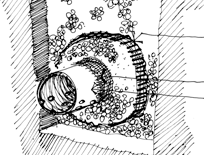French Drains the Right Way

 Most everyone assumes that French drains have their name because engineers in France were way ahead of the curve in figuring out how to deal with the hydrostatic pressure that can damage walls and other types of structures. The truth, however, is that the systems were actually an innovation by an American lawyer and gentleman farmer named Henry French (1813-1885).
Most everyone assumes that French drains have their name because engineers in France were way ahead of the curve in figuring out how to deal with the hydrostatic pressure that can damage walls and other types of structures. The truth, however, is that the systems were actually an innovation by an American lawyer and gentleman farmer named Henry French (1813-1885).
Although French used roofing tiles arranged so that gaps between them admitted water, these days the systems are usually made by placing sections of perforated pipe in areas subject to such pressure. When placed behind retaining walls at the bases of slopes, for example, water flows into the pipes and moves safely away from areas where it could otherwise do great harm.
Through the years, French drains have proved remarkably effective in relieving hydrostatic pressure in a variety of applications. If set up properly, they allow water to follow its natural tendency to pursue the path of least resistance. But if — as happens all too often — these systems are installed incorrectly, the consequences can be extreme and unfortunate. And embarrassing as well, because the problems are so easily avoided.
Scenario: The perforated pipe used to create French drains includes a number of holes, typically in a “Y” pattern, that run down one side of the drain. The mistake many people make is installing the pipe with the holes facing up, under the incorrect assumption that water will flown down into the pipe and then be transported away by gravity.
In reality, that’s not how it works. Instead, the lines should be installed with the holes oriented downward. That way, as water (from irrigation, rainfall or groundwater movement) travels into a critical area, it will well up, follow the path of least resistance into the pipe and be removed.
If the holes face upward, water will have a hard time finding its way into the pipe. In fact, it will need to rise through the gravel and soil surrounding the top of the drain, at which point you will already wind up with saturated soil right next to whatever structure the system is meant to protect.
The consequences of this error can range from the cosmetic to the structural — everything from the delamination of any surface treatment on the outside of the walls or minerals bleeding out of the concrete to collapse of the structure as a result of excessive hydrostatic pressure.
When I’m involved in job inspections as an expert witness and see problems with retaining walls, I usually just pick up a shovel, open the ground and, a majority of the time, find perforated pipe with the holes installed on top.
The Solution: All of these problems are easily avoided if you install the French drain properly — meaning the holes should be on the bottom so the water can readily well up into the pipe.
Of course, even this approach will work only if the pipe is kept clear of debris, which is why you need to install what amounts to a giant sock or sleeve around the pipe and backfill the area with gravel. It’s also a good idea to waterproof the backs of the walls immediately adjacent to the pipe, just to cover all the bases.
Also, French drains should be kept independent of the surface-draining systems used with decks. The reason is simple: If the two systems are connected with a “T” fitting (which commonly occurs) and the surface drain becomes clogged (another common occurrence), water from the surface drains can rise or back up into the French drain line and flow out of the holes. This will quickly saturate the ground around the drain — exactly what you were trying to avoid!
Yes, there are check valves for use with drain systems, but the better solution is to keep French and deck drains on separate lines.
Lesson Learned: This scenario offers a classic instance of something being done because that’s the way it’s always been done. In other words, countless French drains have been installed upside down because that’s simply the conventional approach for too many people.
The lesson here is, don’t assume that just because something has always been done a certain way, it’s the right way. Always ask questions, because sometimes you’ll find out that what you assumed was correct was in fact exactly backwards or upside down.
Scott Cohen is president and supervising designer of The Green Scene, an outdoor design and construction firm based in Northridge, Calif. He provides consultation for clients nationwide and gives seminars on designing landscapes, swimming pools and outdoor kitchens. For more information, go to www.greenscenelandscape.com.









